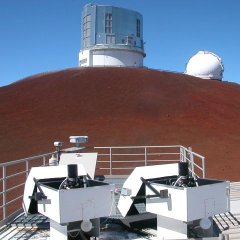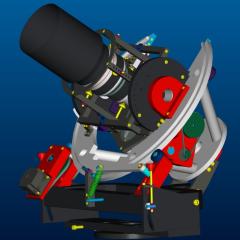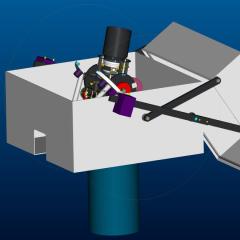


HATNet is a network of six small (11cm diameter), wide-field (8x8deg), fully-automated "HAT" telescopes. The scientific goal of the project is to detect and characterize extrasolar planets (exoplanets; those outside the Solar System), and also to find and follow bright variable stars. The network is maintained by the Harvard-Smithsonian Center for Astrophysics. There are two main stations: the Fred Lawrence Whipple Observatory (FLWO) of the Smithsonian Astrophysical Observatory (SAO) and the Submillimeter Array (SMA) site of SAO atop Mauna Kea, Hawaii.
 |
 |
| FLWO, Arizona | Mauna Kea, Hawaii |
|---|
The HAT acronym stands for Hungarian-made Automated Telescope , because it was developed by a small group of Hungarians who met through the Hungarian Astronomical Association (HAA) back in 1999. The original project was inititated by Bohdan Paczyński (also see here) with the goal of mapping bright variables of the northern sky. The prototype instrument, coined HAT-1, was developed during the undergraduate and first year graduate studies of the PI (Gáspár Bakos) at Eötvös Loránd University and at Konkoly Observatory ( Budapest), as a junior research fellow under the supervision of Dr. Géza Kovács . Development was done with the devoted help of engineers József Lázár, István Papp and Pál Sári from the HAA.
 |
 |
| HAT mount model | HAT dome model |
|---|
The HAT Network was established in 2003, after de-comissioning the prototype instrument HAT-1 at Kitt Peak. The headquarters of operations became the Center for Astrophysics, and significant internal and external funding was used for "spreading the net", and operating the instruments. Over these years, the project matured, and has evolved into a multi-site and multi-instrument network that is searching for the tiny (1%) transit signature of extrasolar planets as they go in front of their central star. We also collaborate with the Wise HAT telescope ( WHAT ) on selected stellar fields to enhance our longitude coverage.
Current operations are supported by a NASA-TPF grant (PI: Prof. Robert Noyes). Very recently we achieved our first transiting exoplanet detection, HAT-P-1b (Bakos et al.~2006).
